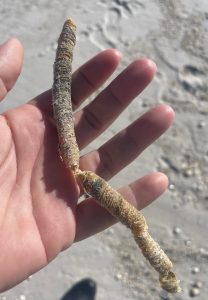
Beachcombing is a fun way to spend time on our local shorelines. While most people are interested in unusual shells or intact sand dollars, other fascinating organisms will wash up in the wrack line as well. One of my favorites is the unassuming but surprisingly tough parchment tube worm (Chaeteopterus variopedatus).
By itself, this small invertebrate would be rather vulnerable and fragile in the open water. Unlike the clams, snails, and whelks, whose beautiful shells end up in collectors’ shelves, the parchment tube worm cannot secrete a protective shell around itself. Instead, it burrows into the sediment, creating a u-shaped tube with openings at both ends. The worms are surrounded with a thin, parchment-type covering that eventually hardens into something the consistency of a cardboard poster tube.

With its parapodia—modified appendages that can perform different functions—the worms feed on passing plankton. Two types of parapodia make this happen. First, parapodia near the tube’s anterior secrete mucus throughout the worm’s body. Fanlike parapodia create a water current that pulls plankton into the tube. Once full, this slimy food pellet moves to the mouth for digestion.
Parchment tube worms live in relatively low-salinity areas, under 20 parts per thousand (ppt). They osmoregulate their bodies, expanding or contracting until internal salinity nearly matches the surrounding water body. A small species of crab has a beneficial relationship with the tube worms, hiding out from predators and capitalizing on the water current to trap and filter feed its own food.

Recent studies have investigated the worms’ ability to create and sustain a bioluminescent blue light within their mucus layers. Most bioluminescent organisms flash or have temporary lighting, but researchers have discovered that the presence of a form of iron called ferritin serves like an energy-storing battery. As the chemical pathway of this phenomenon is studied, it may yield new ways on how to create more effective rechargeable (and biodegradable) light sources for commercial or medical applications. Functionally, researchers are split as to why the worms produce such a glow. Theories include the idea that this sustained light may function to lure in potential food sources, or conversely as a sort of “burglar warning” that wards off predators. Like many other worms, parchment tube worms can regenerate segments if they are lost during predation.
Walking on the beach, you’ll recognize the tube worms’ multilayer exoskeleton as a thin, sand-colored tube consisting of thin concentric circles. Sometimes, the slim, reddish worms will still be inside, but typically they have already died or dried out.
 7
7
